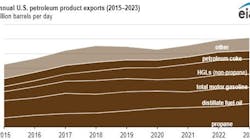Sam Fletcher
OGJ Senior Writer
HOUSTON, June 27 -- Crude oil and natural gas futures inched up less than a fraction of 1% each in the New York market on June 24, but front-month North Sea Brent continued falling, down more than $2/bbl.
“Oil products largely followed Brent and traded lower, but to a lesser extent, which should lend much-needed support to refiners. Facing increased supply in the near term for waterborne crude, the Brent term structure continued to collapse, the Brent-West Texas spread narrowed substantially, and the premium of US domestic waterborne crude (such as Light Louisiana Sweet) over WTI weakened significantly,” said James Zhang at Standard New York Securities Inc., the Standard Bank Group.
On the same day, the US Commerce Department announced its final reading of gross domestic product growth in the first quarter of this year at 1.9%.
That is higher than previous estimates (1.8%) and above Wall Street's expectations (also 1.8%), said analysts in the Houston office of Raymond James & Associates Inc. “Despite the positive economic news, the broader market remained fickle, dropping 1%. Energy stocks did not fare any better,” they said. “Separately, commodities remained relatively flat, with both oil and gas gaining.” But prices for both oil and gas were down in early trading June 27.
The final read for the first-quarter US GDP “is less important” than the actions of the Federal Reserve System “and most banks revising down their GDP outlook for the second quarter,” said Olivier Jakob at Petromatrix in Zug, Switzerland.
So far, the Standard & Poor’s 500 index is down 4.33% for the second quarter that is now coming to an end, Olivier noted. “The NASDAQ was up 1.39% for the week but is flat for the year and down 4.61% for the quarter. The S&P tried to rebound from the 200-day moving average and out of the descending channel, but lack of optimism from [Fed Chairman Ben] Bernanke and the International Energy Agency’s [60 million bbl of oil] stock release [from the strategic reserves of 28 countries, including 30 million bbl in the US] pushed the S&P down, back to the support of the 200-day moving average.”
Jakob said, “The problem in the equity markets remains with the financial sector, which is unable to really recover. With 16.3% of the S&P in the financial sector, the S&P…needs the other sectors to outperform to offset the losses in the financial sector; if the energy sector, which is 12.5% of the S&P 500, starts to move lower with lower oil prices then it will be harder and harder for the index to stay above the 200-day moving average.”
Moreover, he said, “Year-to-date losses in the banking sector are starting to reach critical levels and the big Wall Street firms are starting to test their 2010 lows…. If we print a confirmed break of the 2010 lows for the large US banks, then technically we move back to 2009 for the search of support levels.”
Last week, front-month WTI and Brent had net losses of $1.85/bbl and $8.09/bbl, respectively. “While economic data continue to show a softening economy, the price drop in oil was mainly driven by the IEA's decision to release 60 million bbl of oil to the market over the next 30 days (from this week),” said Zhang. “This decision represents a major policy shift from the agency and its member countries, as the previous two coordinated releases were on the back of major supply disruptions. One was Hurricane Katrina, another was the Iraq War.”
This time, he said, “There have been no major supply disruptions. Moreover, the market has shown considerable sign of weakness since mid-May on a softening global economy. It came as no surprise that the Organization of Petroleum Exporting Countries has denounced the IEA's move. The big question is how this decision will affect Saudi's intention to ramp up production. For now, an increase of light and sweet crude supply from the IEA reserve release is likely to see the sweet and sour spread narrow.”
Another Standard Bank analyst said, “The oil market looks particularly susceptible to sudden moves; therefore, our preference is for trading time spreads rather than flat prices.”
Energy prices
The August contract for benchmark US light, sweet crudes crept up 14¢ to $91.16 June 24 on the New York Mercantile Exchange. The September contract gained 17¢ to $91.71/bbl. On the US spot market, WTI at Cushing, Okla., was up 14¢ to $91.16/bbl.
Prices of most other energy commodities continued to decline, however. Heating oil for July delivery decreased 3.14¢ to $2.75/gal on NYMEX. Reformulated blend stock for oxygenate blending for the same month lost 6.1¢ to $2.78/gal.
The July contract for natural gas, however, advanced 3.6¢ to $4.23/MMbtu on NYMEX. On the US spot market, gas at Henry Hub, La., fell 7.8¢ to $4.21/MMbtu.
In London, the August IPE contract for North Sea Brent was down $2.14 to $105.12/bbl. Gas oil for July dropped $14.50 to $874.50/tonne.
The average price for OPEC’s basket of 12 benchmark crudes fell $3.17 to $102.91/bbl. So far this year, however, the OPEC basket price has averaged $106.79/bbl.
Contact Sam Fletcher at [email protected].

